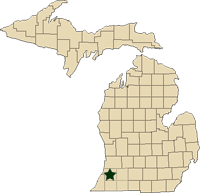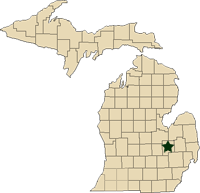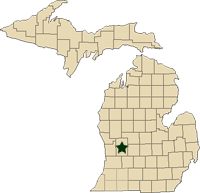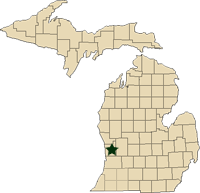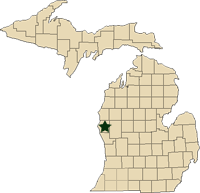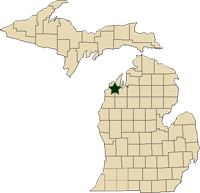Regional reports on Michigan fruit – July 12, 2011
MSU Extension educators’ pest and fruit updates for Michigan
This week’s regional reports:
-
Southwest Michigan - Mark Longstroth, Bill Shane, Diane Brown-Rytlewski
-
Southeast Michigan - Bob Tritten
-
Grand Rapids Area Tree Fruit - Amy Irish Brown and Phil Schwallier
-
Grand Rapids Area Small Fruit – Carlos García-Salazar
-
West Central Michigan - Mira Danilovich
-
Northwest Michigan - Nikki Rothwell, Duke Elsner, Erin Lizotte
Southwest Michigan – Mark Longstroth, Bill Shane, Diane Brown-Rytlewski, Michigan State University Extension
|
|
The beginning of July has been warm with highs generally in the 80s. Strong storms moved down the Lake Michigan shore on June 30 and July 1, but these storms only affected the coastal counties. Rainfall was almost an inch close to Lake Michigan. Rainfall away from the lake was only 1/4 to 1/3 of an inch. Soils were drying out due to the lack of rain and corn leaves are rolling up in sandy soils. A strong storm front moved across southern Michigan on July 11 with strong winds and heavy rains. These storms left a path of downed and broken trees in their wake. Heavy rain fell across the region. Rainfall totals range from about a half inch to 1.5 inches. There were no reports of hail in this storm. Soil temperatures are in the mid-60s. We are close to normal fruit development, but growing degree accumulation for 2011 is well behind last year. Check for the weather station closest to you at Enviro-weather.
|
Southwest Michigan Growing Degree Day Totals from March 1 through July 10 |
|||
|
Location |
GDD 42 |
GDD 45 |
GDD 50 |
|
1843 |
1572 |
1168 |
|
|
1703 |
1447 |
1063 |
|
Tree fruit
Following Monday’s heavy rain (July 11), cherry fruit flies and apple maggot should emerge in good numbers. Japanese beetles are easy to find and are congregating in groups on favored feeding sites. Oriental fruit moth trap catches are up, indicating the start of the second generation. San Jose scale crawlers are out and are causing red spots on fruit. Potato leafhopper damage can be found in many crops. Birds are feeding on ripening cherries and causing serious damage to small plantings, forcing a quick harvest of the remaining fruit.
Apricot harvest has ended.
In peaches, early season peach varieties are coloring. Oriental fruit moth trap catch is indicating the start of the flight of the second generation. Bacterial spot symptoms on leaves and rusty spot symptoms on fruit are easy to find in some orchards. Some growers report the loss of trees blown down in Monday’s storm.
Sweet cherry harvest continues. Birds feeding and brown rot are the major problems with harvest. Cherry fruit flies have been trapped and fruit that will not be harvested quickly should be protected.
Tart cherry harvest has begun. Wind whip damage is the major problem on fruit and also serves as a point of entry for brown rot infection of the fruit. The strong winds Monday morning caused extensive damage in some orchards, breaking limbs and trees, knocking fruit off trees and wind wiping the remaining fruit. Cherry leaf spot symptoms are easy to find in the tree tops of many orchards. Cherry leaf spot has completely defoliated some trees in neglected orchards.
Plums should be protected from brown rot and apple maggot. White apple leafhoppers also attack plum leaves. Many plum trees are now leaning due to the effects of Monday’s storms and will need to be propped up and staked.
In apples, new fire blight symptoms from internal and tree-to-tree movement of the disease are apparent. After Monday’s storm, we can expect more movement in orchards that have active fire blight. We have had no reports of damage in trellised high density orchards, but some unsupported semi-dwarf trees are leaning and will need to be righted, propped and supported. Apple scab symptoms are becoming easier to find. The second generation of oriental fruit moth is flying. Biofix was set as last Friday, July 8.
Codling moth trap catches are declining. Codling moth biofix was June 1 or 3. We are about 800 GDD base 50 after biofix and the second generation should emerge in about two weeks. Obliquebanded leafroller biofix in southwest Michigan was June 13. We are about 750 GDD beyond biofix and many growers have applied their second control spray. Growers and scouts should have apple maggot traps out. Apple maggot will emerge in July and August after 0.25 inches of rain and we expect a strong emergence this week after Monday’s rain.
Pear fruit are 2 inches in diameter. Pear psylla adults, eggs and nymphs can be found. Second generation codling moth is a concern in pears, depending on the insect population.
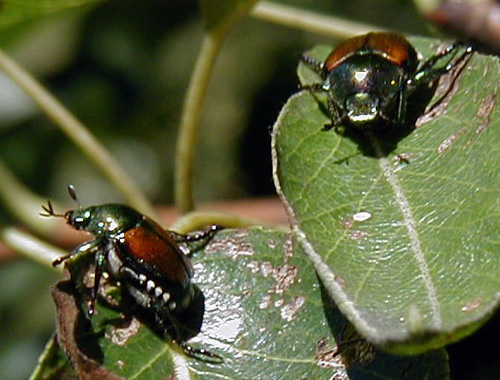
Japanese beetle feeding on pear leaves. Note the white tufts of hair along the
side of the abdomen insuring a positive ID of this pest.
Small fruit
Japanese beetles are easy to find and are congregating in groups in many small fruit plantings.
In grapes,Concord and Niagara are at berry touch. Wine grapes are at cluster tightening. Now is the time for botrytis bunch rot sprays to coat the interior of the berry bunches while they are still exposed. We are just past 1200 GDD base 50 from April 1, and grape berries are about half their final size. We have a very heavy grape crop and growers should consider estimating their crop at 1200 GDD and thinning the fruit down to manageable levels. Grape berry moth second generation controls should be applied. We set biofix (bloom in wild grape) for grape berry moth May 30-31 in Berrien County and June 1-2 in Van Buren County.
810 GDD base 47 after biofix marks the beginning of egglaying, and the recommended timing for insecticides to control grape berry moth. We passed the 810 GDD mark on July 4 at Scottdale and July 8 at Bainbridge in Berrien County, and July 7 in Lawton and July 9 at Teapot Dome in Van Buren County. We are now around the 910 GDD base 47 and past time to apply products that kill the larvae, such as organophosphates, carbamates and pyrethroids. Check the grape berry moth model for timing based on the Enviro-weather station closest to your vineyard. Grape leafhopper and potato leafhopper are out, but no major damage has been seen. Japanese beetle feeding in vineyards has increased this week. The grape mildew diseases are the primary disease concern now. Powdery mildew symptoms have been found on Concord fruit. Downy mildew symptoms have been observed at generally low levels in commercial vineyards, and at moderate levels in untreated research plots. Berries are no longer susceptible to black rot for most varieties and no new Phomopsis infections are likely. Severe anthracnose has been observed in table grapes in some research plots.
Blueberries are being harvested across the region. The harvest of Bluecrop began last week. Shoot growth has slowed or stopped with the heat and hot weather. Cane collapse from phomopsis cane blight continues. Insects of concern include Japanese beetle and blueberry maggot. Groups of Japanese beetles are feeding and mating in the fields. With the rains on Monday (July 11), we can expect the widespread emergence of blueberry maggot. See MSU entomologist Isaacs’ and Wise’s article on Management strategies for blueberry maggot. Anthracnose fruit rot can be found on ripening fruit. Glyphosate herbicide injury symptoms are very common in blueberries this year.
Strawberry harvest is over and renovation has begun (Read Time to renovate strawberries for more information on renovation). Strawberry fields are mowed and then the rows are narrowed to 12 inches. Fertilizers and herbicides are applied and the fields irrigated to develop a strong stand for next year’s crop. Growers should be prepared to control potato leafhoppers, which can stunt strawberry growth.
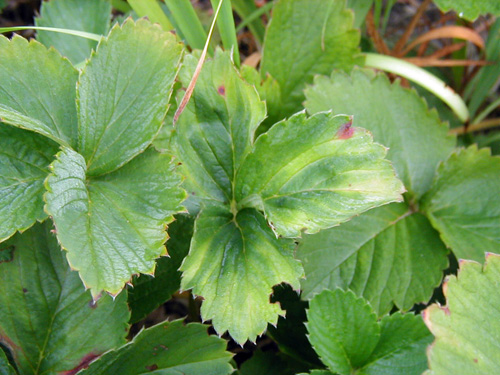
Potato leafhopper burn on strawberry leaves. Healthy leaf on the left and affect
leaf in the center. Note the yellowing at the margin of the leaf and the yellow
streaks spreading out to the leaf edge, marking the sites of feeding where the
insect injected a toxin into the plant.
In brambles, harvest of summer bearing red raspberries and black raspberries continues. Two-spotted spider mites have been found in raspberries. Growers should protect against Japanese beetles.
Southeast Michigan – Bob Tritten, Michigan State University Extension
|
|
Weather
Another round of thunderstorms moved across the region yesterday morning (July 11) from Flint southward, bringing only a few tenths of an inch of rainfall to most fruit farms. Strong, straight-line winds caused some wind whipping of sweet and tart cherries, and a few trees were tipped over. No hail was reported in these storms.
Our soils remain very dry at most fruit farms across the region. Most growers are starting to see signs of drought stress, particularly on newly planted tree and small fruits. Growers are spending more and more time irrigating fruit crops.
|
Southeast Michigan Growing Degree Day Totals for March 1 to July 11 |
|||
|
Location |
GDD42 |
GDD45 |
GDD50 |
|
1811 |
1553 |
1165 |
|
|
1743 |
1489 |
1109 |
|
|
Flint (Genesee) |
1822 |
1562 |
1175 |
|
1813 |
1557 |
1172 |
|
|
1945 |
1672 |
1259 |
|
|
1624 |
1378 |
1014 |
|
|
1794 |
1539 |
1157 |
|
Tree fruits
Apples continue to size well, with most varieties 2 inches in diameter. Hand-thinning continues on Honeycrisp, Fuji, Gala and a few other selected varieties.
San Jose scale crawler activity continues, however I am starting to see a few crawlers that are beginning to molt. So, the window for crawler control is beginning to close. Japanese beetle continues to be found, however, in low numbers. I am waiting to begin to see their numbers increase in the next week or so. Potato leafhopper populations continue to be high in many apple blocks. Codling moth trap catches remain low in most apple blocks, with just a few very small larvae being found late last week.
Many growers have applied an insecticide to control green apple aphids. No apple maggots have been caught in traps this week or this season. I expect to see some emerge where farms received rain from yesterday’s thunderstorms. I have not seen any brown marmorated stink bugs, although I continue to get calls from growers on “look-a-likes” in the stink bug family. European red mite populations have begun to bronze the inside middles of some Red Delicious blocks. I continue to see good numbers of predators in apples.
Light amounts of apple scab continue to show up. Growers are starting to apply their first summer fungicides to control sooty blotch and fly speck.
Pears are mostly 1.5 inches. I continue to find active populations of pear psylla where suckers have not been removed in pear blocks.
Peach size remains about the same at 1.5 inches in diameter. Peach leaf drop continues from bacterial leaf spot infections.
Sweet cherry harvest has wrapped up at a few farms and will continue to later this week at most farms. Cherry fruit trap catches have been lower this week compared to a peak in emergence last week. Leaves infected with cherry leaf spot continue to turn yellow. I am not seeing a great deal of leaf drop – this will occur in the next two weeks or so. Bird feeding was a serious challenge at most farms this season.
Tart cherry harvest continues at almost all farms across the region. An extreme amount of leaf yellowing and drop has occurred in the past week due to cherry leaf spot infection. In some blocks, entire limbs have been defoliated.
Small fruits
Strawberry harvest is now complete at all farms across the region and the renovation process is underway. I encourage strawberry growers to begin the renovation process as soon after harvest as possible. Most growers have applied a broadleaf herbicide (if broadleaf weeds were present), mowed the leaves off, and are now narrowing rows, sub-soiling and applying fertilizer. The final step is to apply a preemergence herbicide. Lastly, I encourage growers to begin to irrigate strawberries quickly after the renovation process is complete to be sure to take advantage of as much of the remaining growing season as possible. This irrigation frequently sets the stage for next year’s crop of berries. Read Time to renovate strawberries for more information.
Raspberry harvest continues for summer red and black raspberries. A much smaller amount of raspberries is being harvested from the bud berries on fall-bearing raspberries. Some cane collapse is occurring from a combination of diseases that infected the canes last season and winter injury. I am starting to see several fields that have high populations of potato leafhoppers that are curling leaves. Growers are encouraged to do a thorough job of scouting for potato leafhoppers this week. There are lesser amounts of leaf curling from powdery mildew.
Blueberries continue to color with a few farms expected to begin harvest of Blueray late this week or early next week. I have not had any catch of blueberry maggot or spotted wing Drosophila.
Grapes are at berry touch for Concord types. I continue to catch a few grape berry moth adults in traps. We are fast approaching the time when second generation adults are beginning egglaying and control measures need to be taken.
Grand Rapids Area Tree Fruit– Amy Irish Brown and Phil Schwallier, Michigan State University Extension
|
|
Weather summary
There were storms on July 1 that brought some hail to the western side of the Grand Rapids tree fruit growing region. Some growers were hit significantly with 50 percent of their apples affected, but overall, less than 5 percent of the whole region was affected. Heavy rain moved through again on July 11 with no hail being reported. Rainfall totals were variable in the area. The table below is a summary of rainfall totals for July 11, 2011.
|
Weather Station |
Rainfall (inches) |
|
0.34 |
|
|
0.62 |
|
|
0.81 |
|
|
0.44 |
|
|
1.22 |
There were some impressive, five-minute rainfall totals from the Sparta Enviro-weather station on July 11. In a 15-minute period, just under an inch of rain fell: 0.27 inches fell between 8:10 and 8:15 a.m.; 0.51 inches fell between 8:15 and 8:20 a.m.; and 0.17 inches fell between 8:20 and 8:25 a.m.
Tree fruit growth stages
Apples are sizing nicely with many fruits at 1.5 inches in diameter. Hand thinning is winding down. Apple shoots are still putting on new growth, but should start setting terminal buds soon. Peach thinning is complete and there is a very nice peach crop shaping up. Sweet cherry harvest is nearing the end and the rains on July 11 caused a great deal of fruit splitting. Apricots are being harvested.
Tree fruit diseases
Apple scab. Keep watching for it and maintain higher rates of fungicides in blocks with scab present. Fruit and leaves are still somewhat susceptible to further infections, so maintain a good fungicide cover in blocks with active scab. As we move into late July and through August, it is thought that leaves and fruits are more resistant to scab infections, but they become susceptible again near harvest, which usually results in pinpoint scab on fruits coming out of storage. Stay covered with a good fungicide rate in blocks with active scab to keep it from infecting fruits.
Fire blight. We are moving into a period when active tree growth is slowing and this means that the spread of fire blight should be slowing, too. Once we get into July, there should be no further risk of fire blight spread in blocks that are currently free of fire blight, and sprays for any trauma events are not necessary. If you have blocks with active blight, they should be covered in the event of a trauma blight situation. All clean blocks do not need cover sprays for trauma situations.
Tree fruit insects
Codling moth biofix for the Grand Rapids area was set for May 30. As of midnight on Monday, July 11, we accumulated 756 DD base 50, which means we are well into egg hatch and it should be coming to an end for the first generation in about a week or so. Cover sprays are still important to maintain in blocks over threshold.
Obliquebanded leafroller flight is declining, but activity of larvae is on the increase. A regional biofix was set for June 14. We’ve accumulated 714 DD base 42 since the biofix date. We are probably just past peak hatch right now. Small larvae are becoming easier and easier to find in terminals. When you see two to three larvae infested terminals per tree, control sprays are needed.
Japanese beetles are starting to show up. Try to keep their numbers down as you see them move in. Read MSU entomologists Isaacs’ and Wise’s article on Managing Japanese beetles in fruit crops.
European red mites can be found in all life stages. Monitor mites closely and don’t wait too long and let populations grow too much before applying a summer miticide. The high temperatures in the next week will cause populations to increase quickly.
White apple leafhoppers and potato leafhoppers are present in all life stages. Numbers are normal to slightly above normal, and even quite high in some non-bearing trees. Blocks with higher numbers need control sprays to prevent shoot growth shutdown.
Oriental fruit moth degree days base 45 since biofix back on May 12 are at 1232, which indicates that second generation eggs are beginning to hatch and cover sprays in peaches and plums are again important.
Dogwood borer flight is most likely at a peak, so trunk sprays in apples should be applied now. The pre-harvest interval for trunk sprays of Lorsban is 28 days.
Grand Rapids Area Small Fruit– Carlos García-Salazar, Michigan State University Extension
|
|
Weather in the Grand Rapids region has been hot and humid with temperatures in the upper 80s. Rain accumulation during the past seven days has been more than 1 inch, although this accumulation occurred in the last 48 hours. There were some thunderstorms that produced hail in some counties. However, no major damage to crops has been reported by growers. So far, degree-day accumulation in the area has reached 1126-1140 GDD (base 50).
Blueberry harvest has started in the Grand Rapids region. Duke and other early varieties are in harvest and Bluecrop will start this week. Strawberryharvest has finished and renovation has started. Yields were not very good due to winter damage. On the other hand, summer raspberries are maturing and the first harvest has started in some fields.
Blueberry diseases are the major problem in many fields. Phomopsis canker is showing in most fields and collapsed canes and plants are a serious problem for some growers. However, at this time there is little that can be done about it except wait until the harvest is over. After harvest, it is recommended to go back into the fields and eliminate as many cankers as possible to avoid the spread of the disease to the new growth. Phomosis has been a serious problem, especially in those fields that has damage due to hail storms. Growers need to inspect their fields after a hail storm to determine if plants were damaged. If that is the case, a fungicide application is required for preventing further infections by Phomopsisi or other plant disease. Left untreated, fields affected will suffer severe canker infections the following season.
Regarding insect problems, there are reports of Japanese beetles in blueberry fields, but numbers are still low. As a result of the intense rains from the past 48 hours, we expect a large emergence of blueberry maggot flies and growers need to be alert and ready to apply the recommended control measures in case it is needed. The spotted wing Drosophila has not been found, but we continue its monitoring in blueberries and raspberries.
West Central Michigan – Mira Danilovich, Michigan State University Extension
|
|
Weather
Summer has arrived! Finally, some steady and summer-like temperatures. Daily high temperatures were in high 70s and into the 80s. Night temperatures, with the exception of the last couple of days, were quite pleasant with the averages in the 40s and 50s. This morning’s rain has been a welcomed sight. Evapotranspiration has been high and precipitation scarce creating significant moisture deficit in the soil.
Tree fruit
The rain yesterday morning (July 11) was short-lived but very intense. Our Enviro-weather stations registered 1.07 inches in Hart and 0.78 inches in the Ludington area. Weekly forecast is indicating possible rain every day except Wednesday (July 13). Unless we get heavy rains, our cherries should be able to handle the “pressure.”
Sweet cherries are being harvested. So far, the quality has been good. The area is gearing up for the tart cherry harvest. A few growers have started to harvest tart cherries this week. Apples, pears, peaches and plums are developing nicely.
West Central Michigan Growing Degree Day Totals Since March 1 as of Monday, July 11
|
Location |
DD42 |
DD45 |
DD50 |
Rainfall |
|
|
Last 2-Week2 |
Since 4/1 |
||||
|
1618 |
1370 |
1000 |
1.99 |
11.14 |
|
|
1540 |
1295 |
934 |
2.43 |
13.32 |
|
Insects
At the beginning of July, codling moth numbers have jumped from slightly above one per trap to 13 per trap. In the abandoned block, the numbers have gone up to 29 per trap. This qualifies as second-generation emergence. The biofix for the second generation is July 2 with 789 DD50.. Obliquebanded leafroller numbers are still going down. Oriental fruit moth numbers are climbing, indicating the emergence of the second generation. There is emergence of the second generation in American plum borer, lesser peachtree borer and great peachtree borer. Rose chafer numbers are very high. They seem to like chestnuts as well as the other fruit trees. In many blocks, treatment for their control is recommended. When it comes to chestnuts, growers need to wait for bloom to end before they can spray for any insect control at this point.
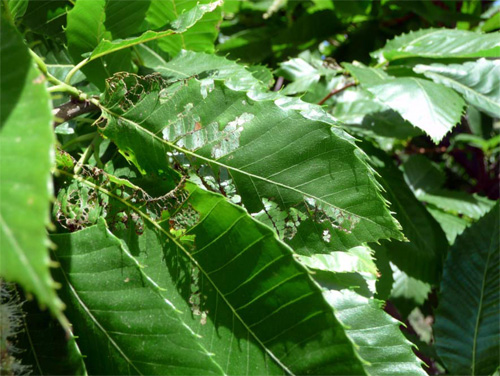
Rose chafer injury on chestnut leaves.
With the hot weather, the spider mite population is exploding. Growers are advised to pay close attention to mite numbers whether they are monitoring themselves or have a scouting service. Heavy mite populations at this time will lead to bronzing of the leaves, thus impaired photosynthesis that would ultimately result in diminished fruit quality. Same statement could be made for leafhoppers. There is noticeable increase in their numbers as well. First cherry fruit fly was caught on June 30. By now, growers have applied the first control cover. Yesterday’s rain will favor and enhance their emergence, necessitating control applications in the blocks that will not be harvested within a week. No reports of apple maggot emergence.
Diseases
Yesterday’s rain is not expected to cause major splitting and rotting. Dryer and cooler weather is ahead at least for the next day or two. Sweet cherry splitting is on everybody’s mind. So far, growers were able to successfully control early splitting. There are no significant rots present. Hopefully, the weather will cooperate, allowing us to get the crop out of the trees. Tart cherries are showing symptoms of cherry leaf spot, cherry mottle and cherry yellows. Peaches are showing symptoms of bacterial spot and powdery mildew on the fruit. Some fire blight, mainly shoot blight, present in apple blocks throughout the region.
Northwest Michigan – Nikki Rothwell, Duke Elsner, Erin Lizotte, Michigan State University Extension
|
|
Weather
Summer has truly arrived in the north. We have had daytime temperatures in the 80s and most nights have been cool – 50s and 60s. The warm temperatures have really moved along our degree days. The NWMHRS Enviro-weather station is down; we will have our degree day accumulations later in the week. The warm temperatures have also brought no rainfall into the region and soils are quite dry at this time. Most forecasts have predicted thunderstorms over the past week, but most storms have broken up over the lake before they hit our region.
Crop report
Strawberry harvest has ended over the weekend. Growers are starting sweet cherry harvest. At this time, they are picking early varieties for the fresh market and stem-on sweet cherries for the brine market. By the weekend (July 16-17), sweet cherry harvest will be in full swing. For the cool start we had to our spring, harvest seems to be “normal.” Tart cherries are also moving along, and the fruit is 18 mm and red on most trees. As the fruit colors, crops are looking bigger than we originally observed. Fruit quality is looking good at this time. Apples are sizing, and some growers that did not get good thinning are hand-thinning now. Crop loads are looking good in most blocks. Growers are tucking and tying grapes, and we are past bloom for most vinifera varieties.
Pest report
Apples. As apples continue to size, growers should be sure to scout for apple scab lesions to help gauge the risk of fruit scab. Most orchards in the region appear to have made it through primary scab season with relatively clean leaves. Despite high fire blight potential early in the season, very few blossom or shoot blight infections have been observed. Given the wet and warm weather, growers in the north will be keeping an eye out for sooty blotch flyspeck. Sooty blotch flyspeck is more common further south where more moisture is present in the season. Sooty blotch flyspeck is caused by a fungal disease complex (Gloeodes and Leptodontidium and Schizothyrium) of apple in humid fruit growing regions of the United States. The diseases can cause significant economic losses due to the unsightly appearance of affected fruit. Both pathogens colonize the waxy surface of pome fruit, but do not penetrate lower layers.
The two fungi are found on a wide range of perennial hosts commonly found in the woods, including wild brambles. Spores of the two pathogen groups are present in orchards from late pink throughout the summer and into fall. The fungi that cause sooty blotch survive from one season to the next on apple twigs as well as other perennial vegetation with a waxy cuticle. The fungus is dispersed by wind and in windblown rainwater to developing fruit in the spring and early summer. Secondary spread from these primary colonies occurs throughout the summer. Growth of sooty blotch on fruit can begin two to three weeks after petal fall and a week or two later for flyspeck. Growth of these fungi is favored by temperatures between 65 and 80°F and wet, humid conditions. It usually takes 20 to 25 days for colonies of sooty blotch to appear on fruit after infection occurs and three to six weeks for flyspeck.
Control of sooty blotch flyspeck is achieved through dormant and summer pruning and tree training, which open trees and facilitate drying and fungicide deposition, and through preventive fungicidal sprays. Ziram and Captan are rated as very good as protectant sooty blotch flyspeck materials and have activity against apple scab as well, though Captan is a significantly stronger scab material. Removal of wild blackberry from the border of the orchard can help by eliminating a potential reservoir host. There is a sooty blotch flyspeck model available on Enviro-weather that takes the guess work out of determining if fruit is vulnerable to infection. According to the model, we can expect potential infection if we receive more rain in the coming weeks.
Codling moth trap catch last week was zero – this week emergence began again with a total of three moths in six traps. Based on trap catch data from the research station, we set the codling moth biofix for first generation (sustained catch) as May 31 and have accumulated about 500 DD50 since. The moths in the traps this week are likely late emergers from the first generation; second generation codling moth treatment will not begin until approximately 1200 DD50 (though detecting second generation adult biofix and predicting egg hatch is a more accurate gauge of the ideal treatment window for second generation). Growers can track their site-specific progression using the codling moth model.
Obliquebanded leafrollers continue to emerge as adults. Adult moth trap catches are down over the past two weeks with an average of five moths per trap this week, eggs are laid and summer generation larvae hatch has likely begun in area orchards opening another potential obliquebanded leafroller larvae (photo A) treatment window. Growers can scout for multiple life stages of obliquebanded leafrollers; adults moths are easily trapped with pheromone-baited delta traps, and tiny larvae are also likely present at this time and rolling leaves. Growers looking to treat for the summer generation of obliquebanded leafroller larvae can use the obliquebanded leafroller model as a reference.
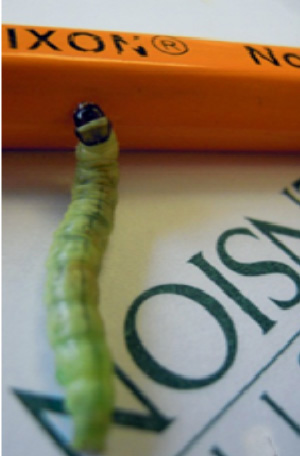
Photo A. Obliquebanded leafroller larvae Photo credit: E. Lizotte, MSUE.
Based on the biology of the insect, we expect egg hatch began 400-450 DD42 after sustained catch (sustained adult trap catch was recorded on June 20 at the NWMHRS). Apple obliquebanded leafroller larvicide materials include Delegate, Entrust, Proclaim, Altacor, Belt, Voliam flexi and Leverage.
Plum curculio egglaying scars in apple have been reported by area scouts, even in conventionally managed sites. There have also been reports of feeding damage. Green apple aphid(photo B) numbers on foliage and fruit have exploded with the warm weather and lots of succulent growth on apples. Always read and follow pesticide labels carefully.
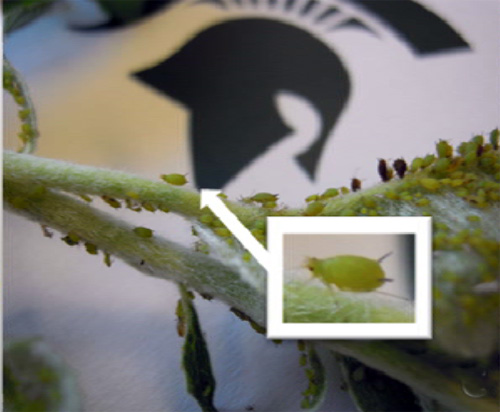
Photo B. Green apple aphid. Photo credit: E. Lizotte, MSUE.
Cherries. Obliquebanded leafroller activity continues in cherry, with adults and tiny larvae present in area orchards at this time. Adult obliquebanded leafroller trap catch averaged eight moths per trap. For growers that were not able to make an application targeting overwintering larvae earlier this season, a second management window is or will open as we approach harvest. Obliquebanded leafrollers have been observed more commonly in both sweet and tart cherry during the past seasons. These insects are not internal feeders in the fruit, and although they can cause some damage from defoliation, the greater concern is their threat as a contamination pest if they are found in cherry tanks at harvest. Growers with problem orchards risk having tank-loads rejected at the processor if obliquebanded leafroller larvae (photo A) are present. Organophosphate resistance (and pyrethroid cross-resistance) in obliquebanded leafrollers are likely one of the factors contributing to larvae in cherry tanks at harvest. Fortunately, there are several new insecticides that have been efficacious against summer generation obliquebanded leafroller larvae. Tart and sweet cherry obliquebanded leafroller larvicides include Delegate, Belt, Altacor, Voliam flexi or Entrust.
As we approach sweet cherry harvest, the pre-harvest interval should be a primary consideration when selecting an insecticide. Optimizing the timing of insecticide applications to effectively target obliquebanded leafrollers in cherries can be particularly challenging. First instar obliquebanded leafrollers are small and can be difficult to spot. At this time of the year, growers should be looking for larvae in cherry clusters – now is the time to be monitoring for these summer generation larvae. The larvae have a distinct black head capsule that is slightly flattened. Obliquebanded leafroller larvae vary from light yellow to green and grow to 1 inch. Growers can also monitor for the adult moths using pheromone baited stick traps. Treatments should be applied if average trap catches approach or exceed 20 moths per trap or two to three active larvae per tree are observed.
Plum curculio activity appears to be waning in cherry with no adults in the traps or observed working in the tree canopy. It appears that second generation American plum borer emergence has begun – delineating between generations can be difficult as trap catches often never stop completely. However, as trap numbers begin to climb, the increased catch of moths indicate the flush of second generation emergence will likely occur in the coming weeks. Lesser peach tree borer emergence has rebounded with an average of three per trap. Peach tree borer numbers are up slightly with an average of one moth per trap.
The first cherry fruit flies of the season were detected in the NWMHRS trap line on July 5. Positive trap catches have also been reported on Old Mission Peninsula and in Benzie County. Numbers were up this week with 63 flies caught in four trap locations. Cherry fruit flies (photo C) emerge for about a month, with peak emergence in late June to early July. Seven to 10 days after emergence, females deposit eggs in the fruit where hatching larvae immediately burrow in and feed. Most control strategies employ insecticides that target the adult stage during that 7- to 10- day window. If flies are trapped on-farm, but a regional trap catch was recorded earlier, the treatment should be timed based on the earlier regional capture to minimize the risk of larvae in the fruit. However, because population size influences trap catch, it is critically important that growers monitor their own farms for cherry fruit flies to help predict population size as well as duration of activity. Larvae mature in the fruit and then drop to the soil where they enter the ground, pupate and start the next generation’s life cycle the following season.

Photo C. Cherry fruit fly. Photo credit: E. Lizotte, MSUE.
Recent work has shown that a great deal of cherry fruit fly activity occurs after harvest providing a postharvest opportunity for management in sites with high populations. Preliminary research has shown that imidacloprid products such as Prey and Pravado work well at the post-harvest application timing seven days after harvest. This spray could be tank-mixed with the post-harvest chlorothalonil application for cherry leaf spot. Refer to MSU Extension Bulletin E-154 Fruit Management Guide for more information and always carefully read and follow pesticide labels.
Black cherry aphids are also visible in significant numbers on the terminals of sweet cherry branches. Black cherry aphid (photo D) feeding curls and stunts leaves and deforms shoot growth. Highly susceptible varieties include Black Tartarian, Napoleon, Schmidt and Windsor. Young cherry trees are especially susceptible to injury and can be killed if infestations are heavy. Severe infestations may also reduce the quantity and quality of the crop on mature trees. Overwintering black cherry aphids eggs hatch as cherry buds begin to open in April. Two to three generations are usually completed on cherry. Several summer generations are produced on alternate hosts, with winged adults returning to cherry orchards in September and October to mate and lay overwintering eggs. There are a number of effective insecticides for the management of black cherry aphids in sweet and tart cherry, including Provado, Actara, Assail, Beleaf, Vloiam flexi, Movento, Voliam flexi and Leverage (management may be delayed until postharvest). As we approach harvest, growers should be aware of the pre-harvest intervals of various materials and always read and follow pesticide labels carefully.
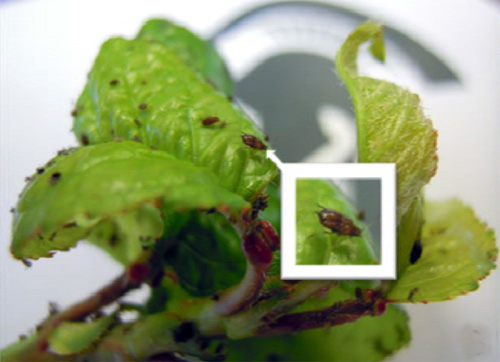
Photo D. Black cherry Aphid. Photo credit: E. Lizotte, MSUE.
The potential for epidemic levels of cherry leaf spot is a concern this season. We began seeing significant cherry leaf spot infections early this season and defoliation is already underway in some blocks, particularly those with foliar bacterial canker infections from this spring. Growers should look closely to determine if it is cherry leaf spot, bacterial canker, virus or phytotoxicity causing defoliation as all are present this season. Cherry leaf spot is resistant to sterol inhibitor fungicides (Indar, Elite, Orbit) in all the major fruit producing areas of Michigan. As cover treatments are applied, remember to alternate the use of fungicide classes and tank-mix dodine and strobilurin fungicides with a full rate of Captan to manage against resistance development. Under cool conditions, copper is an excellent cherry leaf spot material and a good strategy for resistance management; copper rates of 1.2 lbs. metallic copper are adequate. Lime is also recommended as a safener for copper applications, but Imidan cannot be used in this tank-mix due to pH.
Early bacterial canker symptoms allowed American brown rot infections to become established on green fruit early and hail damage and sites with a history of American brown rot are also at risk at this time with weather conditions highly favorable for disease development. Indar should be applied at a 6 fl oz/A rate, a 8 fl oz/A application rate should only be used if a shift in fungal sensitivity is suspected (only Indar 2F is labeled for increased rates). Surfactants, high water application volumes, full covers and slow speeds are important strategies for American brown rot management. Growers looking to treat for cherry leaf spot and hedge their bets against American brown rot could utilize Pristine at this time.
Wine grapes. All cultivars are through with bloom now; some of the earlier hybrids have berries approaching 4 mm in diameter. Fast shoot growth has required prompt attention to shoot positioning and tucking. Powdery mildew is still absent from the station vineyards, but it ought to be out there somewhere – don’t relax efforts to scout for it as we are still in a critical time for protecting the tiny berries.
Potato leafhopper injury has not progressed rapidly in recent weeks, but it is still quite obvious in some sites. Rose chafer adults have lingered on much longer than anticipated, but their feeding injury is virtually done at last. Some grape berry moth adults have been taken in traps; this is the start of the second generation in our area.
We need some volunteers to help tuck shoots at the Northwest Station this Friday, July15. Contact Duke Elsner at 231-922-4822 for more details.
The Viticulture Field Day at the Southwest Michigan Research and Extension Center in Benton Harbor, Mich., is on Wednesday, July 27. Although the program features a lot of juice grape information, it is still a very valuable program for northwest Michigan growers to attend. For more information on the field day, contact Duke Elsner at 231-922-4822.
Saskatoons. Fruit is ripening and harvest should be underway. There have been a few reports of rust fungus infections to leaves, stems and berries in the last two weeks.



 Print
Print Email
Email